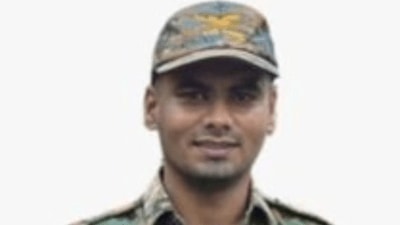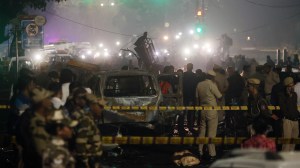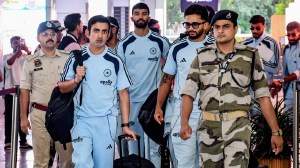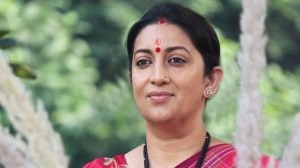15,000 km 28 journalists one story YOUR VOTE
SRINAGARThirtysomething doctors, very patient‘‘We’ve learnt to work around it,’’ he says. It’s a lesson in pat...

SRINAGAR
Thirtysomething doctors, very patient
For, her smile stands out in an overcrowded, grimy ward of the Lalded Hospital. If hope were a person, it would be Fara as she tells you how life in the city is back on the rails. How once again, weddings are celebrated at night, not in the day. How a bomb blast means a traffic jam that needs about an hour to clear.
‘‘It’s all thanks to the Kashmiris who’ve conquered fear,’’ she says.
Look around to see where this hope comes from and you will keep searching. This dank, barrack-like building looks like a forgotten, rundown railway station with corridors crammed with people, a lingering stench, dirty pink walls, rag-like curtains and boards that hang at all kinds of angles.
But for the Kashmir Valley’s mothers-to-be, it’s a godsend. Named after one of Kashmir’s most-loved woman poets, Lalded is the only maternity referral hospital of the Valley with a record 50-odd deliveries a day.
This evening its corridors are filled with one long anguished moan. ‘‘Usually June to August is the peak season for babies, but this time they’ve begun arriving early,’’ Fara laughs.
Perhaps, yet another sign of a Valley on the mend in a hospital that betrays no signs of cheer.
But then, neither does the other speciality institute of the Valley, the Bone and Joint Hospital at Barzullah, a few km away, which receives the maximum number of trauma cases related to militancy. Though less crowded, it is equally decrepit.
‘‘There is no MRI, no CT scan facility, hardly any antibiotics, and there are dogs in the emergency,’’ says 30-year-old Hilal Misgar, a house surgeon doing his MD in orthopaedics, as he takes you beyond the superficial signs like the peeling paint and the filthy floors.
‘‘We’ve learnt to work around it,’’ he says. It’s a lesson in patience he learnt early in life soon after he cleared the medical entrance test for the state Government Medical College in Karan Nagar in 1993. ‘‘Militancy was at its peak and the course which should have taken five years took me eight because of the numerous hartals and strikes that the militants called,’’ he says.
There was fear everywhere. ‘‘I remember the time we were holed up in our house for three days while an encounter took place outside. I was dead sure the securitymen would come in and shoot us all.’’
For Fara, who was in second year at SKIMS Medical College, militancy meant a forced separation from her family. Her brother was sent away to boarding school and her father, Shafi Shaida, a National Conference leader, fled to Delhi after militants began knocking on his door.
‘‘They would just barge into the house and demand shelter, you could do nothing,’’ she recalls. Her mother left for Dubai soon after a CRPF swoopdown on their house at midnight. ‘‘There had been no electricity in town for three days, we both were alone in the house… they swarmed in like bees and combed our house from top to bottom twice over.’’
The worst shock came when the officer in charge told her that they had come to look for her father.
They have survived with their sense of humour intact. ‘‘We’ve grown old, but we have mastered the art of killing time in the long evenings at home,’’ grins Mohammed Mussa, another MD in orthopaedics at the Bone and Joint Hospital.
|
|
|||
They’ve even begun to take death and pain in their stride. ‘‘The other day, I received a Class VIII student who had lost his right hand and left eye in a grenade blast at Baramulla. Then, there is this 60-year-old who was beaten up so mercilessly that he suffered 12 bone fractures.’’
Hilal rues the lack of any semblance of a disaster management cell. ‘‘There is complete chaos everytime there is a major grenade blast, and we get trauma patients.’’
Times, they agree, are changing. The gap between such incidents is increasing. ‘‘The Kashmiris have realised the futility of using the gun,’’ says Hilal.
But they have yet to realise the importance of health. In a Valley fighting for peace, health has never been an election issue. Which is why the Lok Sabha polls don’t excite these young doctors. ‘‘Earlier, I never used to vote out of sheer fear, now I don’t feel inclined to,’’ Hilal shrugs.
The white coat on, they’ve now decided to fight it out themselves. Last December, Hilal and his colleagues struck work for four days to seek more equal pay scales. No, they haven’t got it, but they are trying.
Khalid Parvez, who heads the Doctors’ Association of Kashmir formed in 2001, is lobbying for what he feels would lessen their woes: referral hospitals in the Baramulla and Anantnag districts.
Hilal and friends are also looking at other options, other tests like United States Medical Licensing Exam or its British equivalent.
Fara went a step ahead and flew to the US to deliver her son Shayan, which makes him a US citizen.
And yes, Lok Sabha polls may not matter but Prime Minister Atal Behari Vajpayee does and so does the Indo-Pakistani thaw. ‘‘He is a very good leader, he genuinely wants peace,’’ they all say, as if in a chorus.
You don’t have the heart to ask them who they will vote for — it really doesn’t matter.
PORBANDAR
Forget cricket, look at sea to check for peace
THE road that starts at India’s western-most tip is wide and fast. It’s just that the people who live just a net’s cast away from it don’t care. Not for them the neat dividers and clearly demarcated lanes. The sea has no such markers and the catch they chase has no respect for boundaries.
To the fishermen of Porbandar, this is no philosophical distinction. It’s the difference between jail and livelihood. An aggressive chase sees them cross over to Pakistani waters, where Pakistani officials wait to reel them in.
And now another boat has gone missing. There is an air of resignation when Haribhai Panjro, the 60-year-old owner of Bhuvaneshwari, walks into the office of the Machhimar Boat Association to file an official report. Each boat can cost between Rs 12-17 lakh and Haribhai says: ‘‘You can never trust the sea. It can throw up surprises.’’
But today, a more pleasant surprise is wafting through Porbandar. Away from all that talk of goodwill and the made-for-showcase cricket matches (though they do follow the scores), the fishermen are rooting for Indo-Pakistani friendship.
It affects their lives quite directly. The equation is simple. When India and Pakistan are friendly, very few boats gets hauled in for crossing maritime boundaries. When relations are hostile, the arrests go up.
Only nine boats have gone missing over the past two months and that is great news. ‘‘Before relations improved, they seized 26 boats in one go,’’ says Sunil Gohel, vice-president of the Porbandar Dry Fish Supply Association.
Missing boats mean lost livelihoods and sometimes, lost years. When Pakistani authorities seize these boats, they often take up to two years to give them back. And then, the boats are often stripped bare before they are returned.
Haribhai has had a boat seized before. ‘‘Khali khokhu hatu (only the skeleton was there),’’ he says, to describe what the boat looked like when it was returned to him.
But today, in between worrying about how the families of the missing fishermen will cope, Haribhai is hoping for a miracle. He and his brother have spent about an hour in the office of the Kharwa community and have come back convinced that better ties between the two countries mean that the boat could be returned sooner than expected.
The community decides to make its gratitude known. It passes a resolution thanking the Centre for mending fences with Pakistan and the Gujarat government for promising to compensate fishermen for each day of their stay in Pakistani prisons with Rs 50. Some 50 people whose boats are missing — along with 265 fishermen — sign the resolution.
|
Missing boats mean lost livelihoods and sometimes, lost years… “(But) it is difficult to mark out boundaries in the sea.” |
|||
The Kharwas, numbering some 45,000, though, are a practical people, and they know their boats will keep straying. ‘‘It is difficult to mark out boundaries in the sea,’’ points out Bhimbhai Postaria.
But that’s not the only reason. The best catch is found on the Pakistani side, close to where the Sindhu meets the sea. ‘‘We have to go that far in search of quality catch,’’ he adds.
Since the unstated code of fishermen dictates that they will chase the best fish, wherever it is, the Kharwas can only hope for easier penalties for trespassing. Quite unabashedly, they say they are not loyal to political parties, only to those who can serve their cause. Even Gohel, an active BJP member, declares: ‘‘When it comes to protecting my community’s interests, I can even take on my own party.’’
A couple of days later, Haribhai gets news that his boat is in Pakistani custody. The wait begins even as talk of goodwill continues to find resonance here. But changing tides could change the mood.
KANYAKUMARI
Right at the tip, Robin Hood meets MGR
A top the Vivekananda Rocks, the salt-water spray is gentle on the face. And staring at Land’s End and the vast beyond you think: unity. That’s after you are overwhelmed into silence by the sense of peace at Swamiji’s memorial, and stunned by the 433 feet, 7,000 tonne towering statue of Tamil saint poet Thiruvalluvar 220 feet away into the confluence of the great Indian waters: Arabian Sea and Bay of Bengal.
At the meditation hall inside, two devotees in prayer are seated cross-legged in front of the letter Aum framed in full glow. Aum is the symbol of Absolute God, a total human divine consciousness — recommended by Swamiji as the Great Unifier of all Indian people.
Not many notice these words embedded on a marble plaque at the entrance. And it is surely lost on the primary characters of the election drama that is playing out across the banks in sweltering heat (38-40 degree Celsius) that is Kanyakumari — a timid town in the shadow of politically thriving Nagercoil 20 km away.
The constituency is Tiruchendur. And the battle of the ballot — not a cliche here — has violence in the backdrop. Radha Selvi is proving to be a boon for the DMK, already on a high as the leader of the Democratic Progressive Alliance which includes the MDMK, the two Communist Parties, the Indian Union Muslim League and the Congress, which seems perfectly at ease with sharing the stage with the Pattali Makkal Katchi (PMK), the Tamil separatist outfit that idolises Rajiv Gandhi’s killers.
Selvi is the widow of Venkatesh Pannaiyar, whose death in a police encounter made him a rallying symbol for the dominant Nadar community. And these days, a confident Selvi is campaigning along with her newborn to garner sympathy votes in the name of someone who has had at least seven murder cases slapped against him.
‘‘Give her due, accord justice,’’ cries out DMK strongman and deputy chief M.K. Stalin in a series of quickfire rallies he is holding across southern Tamil Nadu, speeding from town to town. This remarkable agility has less to do with his SUV’s airconditioning than the state of NH-47: smooth as an F1 race track. No, AIADMK’s Damodaran doesn’t stand a chance.
From Thiruvananthapuram, NH-47 passes through Nagercoil and meets Kanyakumari from the west. It is from here that the North-South corridor takes off as NH-7 to touch Tirunelveli, Madurai, Dindigul, Karur, Namakkal and Salem in Tamil Nadu, the distance to Srinagar being 7,300 km.
But it is unlikely that the BJP/NDA will ride this road to success throughout southern Tamil Nadu. Some grudges are personal. D. Jayseelan, former national athlete and now vice-president of the Tamil Nadu Veteran Athletes’ Association, recalls how he had approached the AIADMK’s Radhakrishnan for funds to attend a veterans’ meet.
Radhakrishnan, now Union minister of state for road and transport and a man who may claim some credit for the highway, reportedly told him: ‘‘I don’t take money so I don’t give money.’’ Minus one vote for that.
Here in south Tamil Nadu, there are many like Jayseelan, though not as personally driven, who are flocking to the DPA. At the crux of it is the BJP’s tie-up with Amma, and therefore, just as the CPI(M)’s A.V. Bellaramine is on a strong wicket in Nagercoil, caste and Robin Hood factors help Selvi in Kanyakumari.
It’s evening. For a less than 5 km-stretch that cuts through Kanyakumari and takes us to the beach, Main Road is fascinating in the diverse opinions its permanent residents mouth. Vajpayee is great, says Anantha Krishnan from behind the counter of his daily-needs shop. Only, he should not trust Pakistan so much.
|
“Why do we vote ‘two leaves’ (the AIADMK symbol)? In memory of MGR” |
|||
Why? ‘‘I know from experience,’’ he opens up. ‘‘I served in the Army for 25 years. My last posting was Kargil. The day I boarded the Jammu Tawi Express was the day war was declared.’’
Cloth merchant Somasundaram is ecstatic about DMK ministers coming to his shop to buy towels during campaigning. ‘‘People say the DMK lady will win,’’ he declares.
It’s evening and three days after Chaitrapurnima, the auspicious time to see the setting sun and full moon together. The fishing boats cross Vivekananda Rocks and return with their catch of the day. Fifty-year-old Roopan and 70-year-old Maria Selvan usually make about Rs 100 a day during this time. ‘‘Why do we vote ‘two leaves’ (the AIADMK symbol)? In memory of MGR.’’
It gets dark. The lighthouse swathes the town with periodic high-beams. For a brief moment during every swing, the dome of the Swami Vivekananda Rock Memorial lights up. At other times, it is in silhouette, sombre.
SILCHAR
In tea gardens, only a road will turn a new leaf
As the drizzle turns into a steady fall, Jamui Ram lets out a curse and reaches for a polythene sheet. Another day’s work gone. How he hates the rains. Pushing 50, Jamui Ram no longer remembers home in Sitamarhi in Bihar: ‘‘When you spend a lifetime looking for work, it doesn’t matter where your home is.’’
Jamui says, ‘‘I was 20 when a Marwari businessman came to our village. He said there was money for me if I worked for him in Tinsukia. I ended up unloading his goods from trucks.’’ When he couldn’t take it anymore, young Jamui boarded one of those very trucks and hopped off at a road-construction site.
Lifting boulders looked simpler. Or so he thought.
Thirty years later, Jamui is in Silchar, at the eastern end of a promised road corridor that will stretch, like a giant inch-tape, across the nation’s heartland to end up at Porbandar on the western coast.
But Jamui knows the corridor work is still many months away — a foundation stone was laid just a few weeks ago to announce the dream project that will connect Silchar to Nagaon through the troubled North Cachar Hills. And until then, he has to look for work at lesser sites where they are building culverts, repairing bridges or widening roads.
Road infrastructure, or the lack of it, has become a talking point these elections in the Barak Valley — comprising the Cachar, Karsunday/newspic/20040411/bw8.jpg’ align’left’ vspace’4’>
At the Congress office in Silchar, sitting MP Santosh Mohan Dev says talk of the road is an ‘‘election bluff’’ of the rival BJP. ‘‘Where’s the road? Can you see it? At the pace which they are going, probably my grandson’s son will get to see it. The finance minister is pumping money only for projects in his home state … But I agree, the road, when it comes up, will make quite a difference. Silchar today is a traffic bottleneck.’’
Dev’s not wrong. With long haul trucks joining the clutter of rickshaws, buses and cars, Silchar’s roads are a groan. Bad roads, slow-moving traffic, ethnic clashes in the North Cachar Hills, spurt in kidnappings and extortion are taking a heavy toll of the only industry that powers the Barak Valley economy: tea.
The going has never been so tough for Cachar tea, which contributes 55 million kg to India’s total tea production. Tea officials tell you how they have put up over the years — right from the time East Pakistan came into being, snapping a crucial link — by transporting tea through the long and expensive Shillong-Guwahati road and how the collapse of the Soviet Union, a large patron of Cachar tea, dealt the industry here a body blow.
The Surma Valley Branch of the Indian Tea Association even approached the Commerce Ministry in 2003, highlighting the decline in exports, a slowdown in the consumption rate of growth and the rising production costs which have had a ‘‘disastrous impact’’ on Cachar tea. ‘‘The average price realisation per kg is less than the ex-garden cost of production in majority of the gardens.
|
“When you spend a lifetime looking for work, it doesn’t matter where your home is.“ Jamui has been constructing roads for the past 30 years. His new hope: The East-West Corridor |
|||
‘‘The condition of the National Highways, especially NH-54 extension and NH-44, and roads linked to tea estates are appalling. During the monsoons, which is also the peak manufacturing period in tea estates, dispatch of tea from the Barak Valley and Tripura are held up for days entailing further financial loss to the tea estates … freight charges increase as a result of such pathetic condition of roads and bridges in this region,’’ the Surma Valley Branch told the Ministry.
This being an election year, there’s great expectation here that the governments at the Centre and the state will deliver on at least one count: the Road. Jamui Ram will ditto that.






- 01
- 02
- 03
- 04
- 05

























